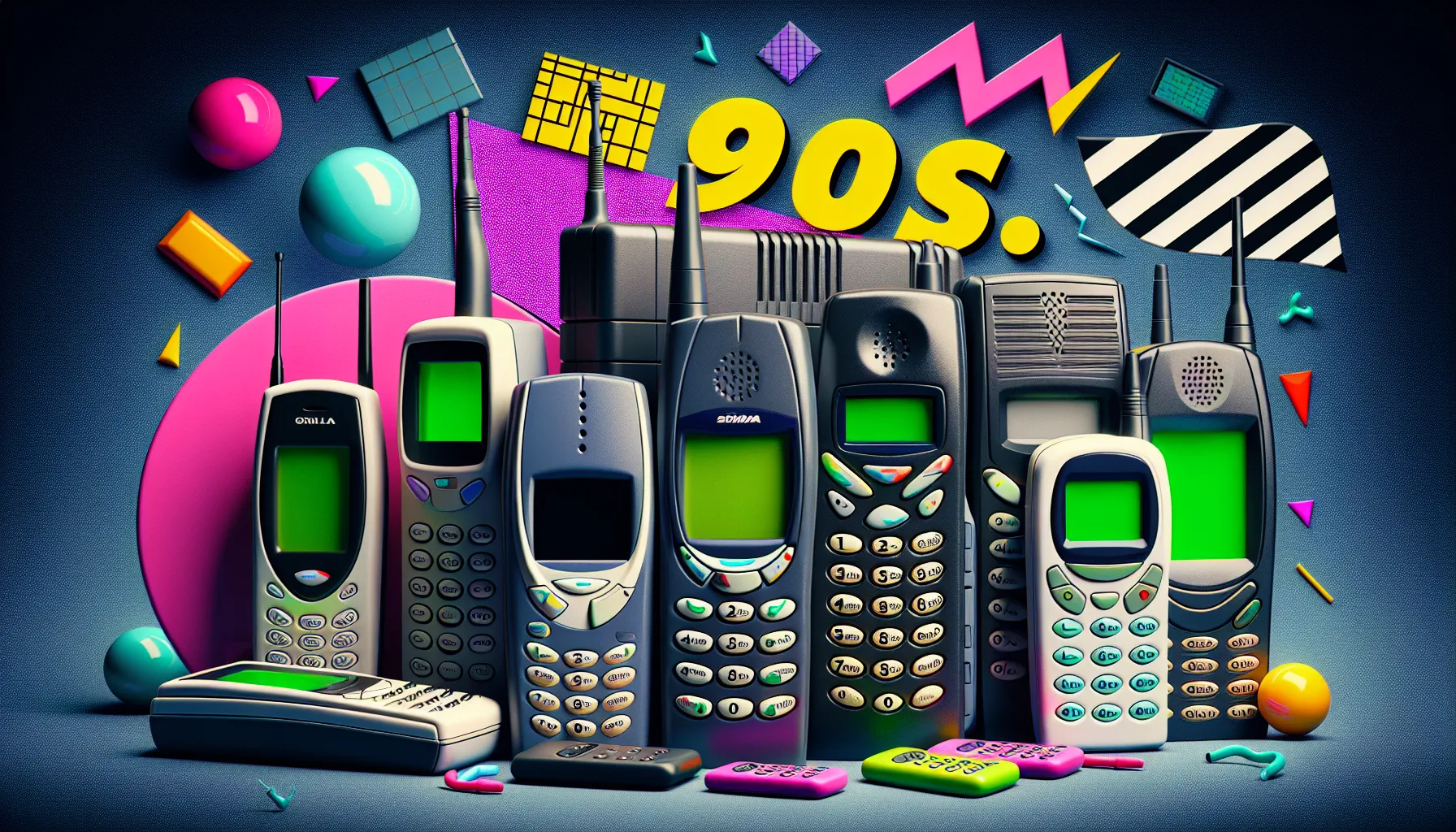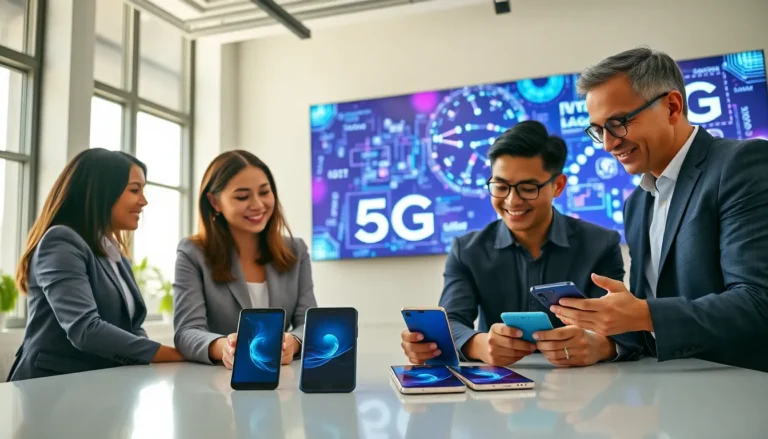Table of Contents
ToggleRemember the days when cell phones were as big as a brick and weighed nearly as much? The 90s brought us a revolution in communication, but it wasn’t without its quirks. Those chunky devices, complete with antennae that could double as a weapon, were the epitome of cool—if you could fit one in your pocket, that is.
Overview of Old Cell Phones in the 90s
Old cell phones from the 1990s showcased a significant transition in communication technology. These devices, often weighing over a pound, featured large displays and basic functionalities. Models like the Motorola StarTAC launched in 1996 represented a major design leap, introducing flip phones to the market.
Antennas were a common sight, extending for better signal reception. Many users struggled with battery life; phones typically operated for just a few hours before needing a recharge. The Nokia 5110, released in 1998, brought durability alongside its famous game, Snake, captivating users.
Text messaging began to emerge during this decade, although keypads lacked the predictive text features found in modern devices. Voice calls remained the primary function, making clear sound quality essential. Early adopters valued the status symbol these cell phones represented, showcasing wealth and modernity.
Carrying these devices proved cumbersome, as pockets couldn’t accommodate their size. Designs emphasized durability, with some models boasting shock resistance. Collectively, these factors contributed to a unique mobile culture, where functionality clashed with fashion.
The 90s also marked the introduction of digital cellular networks, improving call quality and expanding coverage areas. Manufacturers raced to innovate, leading to advancements in signal processing and battery technology. Iconic brands such as Nokia, Motorola, and Ericsson became household names, setting the foundation for the mobile revolution ahead.
Key Features of 90s Cell Phones
Nineties cell phones featured distinct characteristics that set them apart. They combined practicality with a unique style, reflecting the technology of the time.
Design and Aesthetics
Bulky designs defined 90s cell phones. Models like the Motorola StarTAC introduced flipping mechanisms, enhancing portability. Bright colors and angular shapes appealed to users, making them fashion statements. Most devices included external antennas, adding to their unique visual appeal. Compact devices began to emerge, although many were still too large for pockets. Users often displayed these phones as symbols of status and modernity, showcasing their technological prowess.
Technology and Performance
90s cell phones housed basic technology yet provided essential communication capabilities. Analog systems dominated, leading to limited voice call clarity and coverage. Digital cellular networks started appearing, improving performance and reliability. Battery life reached only a few hours, requiring frequent charging. Text messaging emerged as a novel feature but remained secondary to voice calls. Game options like Snake on the Nokia 5110 offered entertainment during downtime. Each of these features played a crucial role in shaping mobile communication’s future.
Popular Models of 90s Cell Phones
The 1990s featured several iconic cell phone models that shaped the mobile landscape. These devices became symbols of innovation and style.
Motorola StarTAC
Introduced in 1996, the Motorola StarTAC revolutionized cell phone design with its flip mechanism. Weighing only 3.1 ounces, it made portability a priority. Users appreciated its sleek, compact design, marking a shift from bulkier models. With a battery life of around 120 minutes, quick recharging became essential for users on the go. Iconic for its beep notifications, the StarTAC also offered basic text messaging capabilities. This phone laid the groundwork for future flip designs and garnered attention for its trendy appeal.
Nokia 5110
Launched in 1998, the Nokia 5110 became a best-seller due to its ruggedness and long battery life of up to 14 days on standby. Its durability made it a go-to option for active users. Featuring the popular game Snake, this phone turned downtime into fun, providing entertainment during calls. The model’s bright colors and customizable faceplates contributed to its popularity, allowing users to express individuality. The Nokia 5110 emphasized functionality alongside style, establishing a legacy that many still remember fondly.
Impact on Communication
Old cell phones from the 1990s fundamentally changed communication. Users experienced a shift from landlines to mobile devices, providing new levels of convenience. Early models like the Motorola StarTAC and Nokia 5110 made it possible to connect with others while on the go. With each call, users appreciated the ability to reach someone instantly rather than relying on payphones or home phones.
Voice calls dominated functionality throughout the decade. Call quality experienced improvement thanks to the advent of digital cellular networks. If users wanted clear conversations, they often sought out areas with strong signal strength. Battery life, however, posed significant challenges. Many devices required recharging after only a few hours of use, limiting users’ ability to stay connected for prolonged periods.
Text messaging emerged as a feature, albeit secondary to voice calls. The introduction of SMS allowed brief exchanges, offering a new layer of communication. While messages were often short and limited, they began to pave the way for the extensive texting culture that followed in later years. Games like Snake provided entertainment, helping to occupy time during phone calls or waiting periods.
Distinctive features of these devices also influenced communication habits. The bulky designs and flip mechanisms contributed to their status as modern accessories. Users frequently showcased their phones as symbols of wealth and prestige. Although basic technology characterized this era, the transformation in mobile connectivity laid the groundwork for future advancements. Communication during the 1990s reflected both emerging technology and societal shifts, marking an essential chapter in the history of connectivity.
Nostalgia and Cultural Significance
The nostalgia associated with 90s cell phones evokes strong memories of a transformative era. These devices weren’t just tools for communication; they reflected a burgeoning digital culture eager to embrace new technology. Fashion-centric designs and bright colors made cell phones status symbols among peers, signaling modernity and wealth.
Users appreciated models like the Motorola StarTAC and Nokia 5110 for their unique features and styles. The StarTAC’s flip mechanism introduced an innovative approach, making portability more fashionable. Meanwhile, the rugged Nokia 5110 became iconic due to its durability and the beloved game Snake, enhancing user interaction and entertainment.
Cultural significance extended beyond mere functionality. Cell phones changed social dynamics, fostering interactions that moved away from landlines. Instant communication grew increasingly common, setting the stage for the fast-paced lifestyle that many enjoy today. Iconic brands like Nokia and Motorola shaped public perception while creating an aspirational atmosphere.
With limited battery life and basic features, these models emphasized sound quality over convenience. Users navigated challenges while marveling at the advancements in technology. As digital networks improved call clarity, they also set the foundation for future communication. Text messaging emerged slowly, hinting at the future of digital communication but still playing a secondary role during the decade.
Cell phones of the 90s undeniably left a lasting impact on society and technology. Combining style with practicality, these devices bridged the gap between traditional communication and the future. Today, the remnants of this mobile culture continue to influence design and functionality in modern smartphones. Remembering these early innovations serves as a tribute to how far mobile communication has come.
The 90s cell phones represent a fascinating chapter in the evolution of communication technology. Their unique designs and iconic features captured the spirit of a generation eager to embrace innovation. Despite their limitations in battery life and functionality, these devices paved the way for the smartphones we rely on today.
The nostalgia surrounding these early mobile phones highlights their cultural significance as status symbols and fashion statements. As users transitioned from landlines to mobile connectivity, the groundwork was laid for the instant communication we enjoy now. The legacy of 90s cell phones continues to influence modern design and functionality, reminding us of the remarkable journey of mobile technology.






